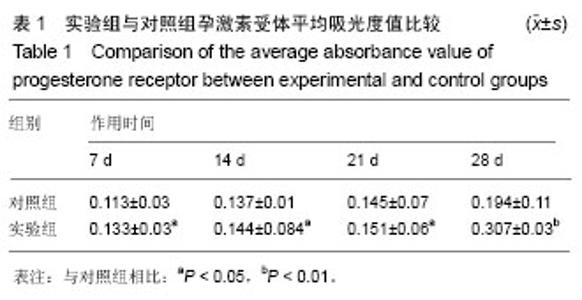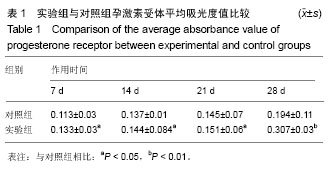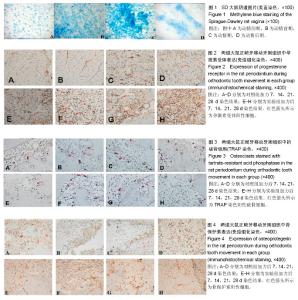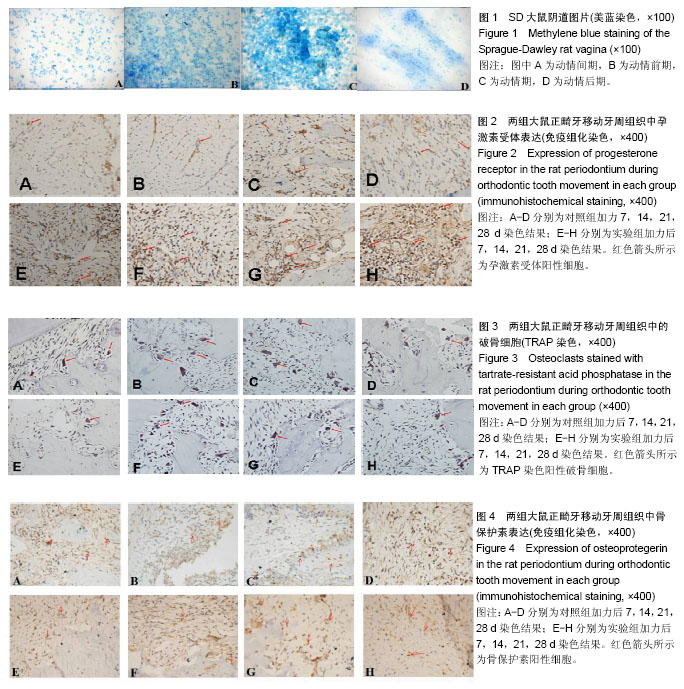Chinese Journal of Tissue Engineering Research ›› 2018, Vol. 22 ›› Issue (4): 542-547.doi: 10.3969/j.issn.2095-4344.0087
Previous Articles Next Articles
Combined oral contraceptives facilitate periodontium remodeling during orthodontic tooth movement in rats
Zhou Yi-fei, Zheng Qian, Mao Jie, Lv Jia-ling, Wu Xiao-ling, Xu Xiao-mei
- Department of Orthodontics, Hospital of Stomatology, Southwest Medical University, Luzhou 646000, Sichuan Province, China
-
Received:2017-11-25Online:2018-02-08Published:2018-02-08 -
Contact:Xu Xiao-mei, M.D., Associate professor, Master’s supervisor, Department of Orthodontics, Hospital of Stomatology, Southwest Medical University, Luzhou 646000, Sichuan Province, China -
About author:Zhou Yi-fei, Studying for master’s degree, Physician, Department of Orthodontics, Hospital of Stomatology, Southwest Medical University, Luzhou 646000, Sichuan Province, China -
Supported by:the Project of Education Department of Sichuan Province, No. 16ZA0188; the Science and Technology Program of Science and Technology Department of Sichuan Province, No. 2015JY0119; the Joint Project of Science and Technology Department of Sichuan Province-Luzhou Municipality-Luzhou Medical University, No. LZ-LY-59
CLC Number:
Cite this article
Zhou Yi-fei, Zheng Qian, Mao Jie, Lv Jia-ling, Wu Xiao-ling, Xu Xiao-mei. Combined oral contraceptives facilitate periodontium remodeling during orthodontic tooth movement in rats[J]. Chinese Journal of Tissue Engineering Research, 2018, 22(4): 542-547.
share this article
Add to citation manager EndNote|Reference Manager|ProCite|BibTeX|RefWorks
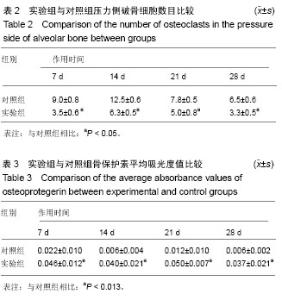
表1结果显示,随着时间的推移,两组孕激素受体的平均吸光度值也随之增大,并在第28天达到最大。在加力第7天,实验组和对照组孕激素受体的平均吸光度值为0.133,0.113,加力第14天分别为0.144,0.137、加力第21天分别为0.151,0.145,组间比较差异有显著性意义(P < 0.05);加力第28天,实验组和对照组孕激素受体的平均吸光度值分别为0.307,0.194,组间比较差异有非常显著性意义(P < 0.01)。 2.3 两组大鼠正畸牙移动牙周组织中破骨细胞计数结果 TRAP染色结果显示,加力后7,14,21,28 d实验组和对照组大鼠第一磨牙近中压力侧牙槽骨切片中均观察到TRAP染色阳性的破骨细胞(图3)。 表2结果显示,实验组和对照组大鼠第一磨牙近中破骨细胞数目均在加力14 d时达到最高值,加力7,14,21,28 d对照组大鼠第一磨牙近中的破骨细胞数目均多于同时段实验组,且差异有显著性意义(P < 0.05)。 2.4 两组大鼠正畸牙移动牙周组织中骨保护素表达结果 实验组和对照组大鼠第一磨牙近中加力侧牙槽骨切片中均观察到阳性染色细胞,在细胞核呈特异性的棕黄色,部分细胞的胞浆中也同样出现棕黄色颗粒(图4)。 表3结果显示,在加力第7天实验组和对照组骨保护素的平均吸光度值为0.046,0.022,加力第14天分别为0.040,0.006,加力第21天分别为0.050,0.012,组间比较差异有显著性意义(P < 0.05);加力第28天,实验组骨保护素的平均吸光度值(0.037±0.021)高于对照组(0.006±0.002),组间比较差异有非常显著性意义(P < 0.01)。"
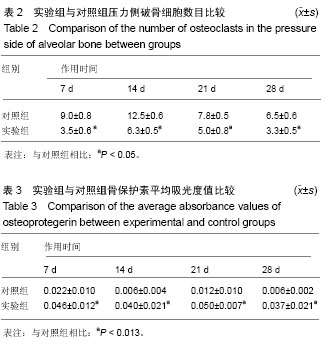
| [1] Wolski H. Selected aspects of oral contraception side effects. Ginekol Pol. 2014;85(12):944-949[2] Caserta D,Ralli E,Matteucci E,et al. Combined oral contraceptives: health benefits beyond contraception. Panminerva Med. 2014, Sep;56(3):233-244.[3] Kulshrestha RS, Tandon R, Chandra P. Canine retraction, et al. A systematic review of different methods used. J Orthod Sci. 2015;4(1):1-8.[4] 李洪亮,司家文,沈国芳等.骨代谢过程中雌激素的影响与作用[J].中国组织工程研究,2015,19(7):1077-1081.[5] Kousteni S, Bellido T, Plotkin LI, etal.Nongenotropic, sex-nonspecific signaling through the estrogen or androgen receptors: dissociation from transcriptional activity.Cell. 2001; 104:719-730.[6] Kousteni S,Han L,Chen JR,et al.Kinase-mediated regulation of common transcription factors accounts for the bone-protective effects of sex steroids.J Clin Invest. 2003; 111:1651-1664.[7] 鲁世金,张宏其,高其乐,等.雌激素受体基因ERβ与小鼠成骨细胞的增殖和分化[J].中国组织工程研究与临床康复, 2011, 15(28): 5157-5160.[8] 梁敏,廖二元.孕酮对体外培养人成骨细胞增殖和分化的促进作用[J].中国临床康复,2004,8(32):7127-7129.[9] 张海龙,黄朝梁.骨保护素的研究进展[J].中华医学杂志,2006, 86(31):2227-2230.[10] Boyce BF, Xing L. Biology of RANK, RANKL, and osteoprotegerin. Arthritis Res Ther. 2007;9(Suppl 1):S1. [11] 张侬,谢妮,耿发云等.雌激素干预对人牙周膜细胞增殖及骨保护素表达的作用[J].现代预防医学,2009,36(9):1736-1738.[12] Silva BC, Bilezikian JP. Parathyroid hormone: anabolic and catabolic actionson the skeleton. Curr Opin Pharmacol. 2015;22:41-50.[13] Osta B, Benedetti G, Miossec P. Classical and Paradoxical Effects of TNF-α on Bone Homeostasis. Frontiers in Immunology. 2014;5:48.[14] 蒋真斌,孙嘉.白细胞介素-17与骨质疏松[J].国际内分泌代谢杂志,2014,34(2):103-105.[15] Grosset C, Peters S, Peron F, et al.Contraceptive effect and potential side-effects of deslorelin acetate implants in rats (Rattusnorvegicus): Preliminary observations. Can J Vet Res. 2012;76(3):209-214.[16] 李振兴,陈传俊.雌激素降低对大鼠髁突软骨ERα、 ERβ、OPG和RANKL表达的影响[J].上海口腔医学, 2015,24(4): 437-441.[17] Rody WJ, King GJ, Gu GM. Osteoclast recruitment to sites of compression in orthodontic tooth movement.Am J Orthod Dentofacial Orthop. 2001;120(5):477-489.[18] Boivin G, Anthoine-Terrier C, Morel G. Ultrastructural location of endogenous hormones and receptors in bone tissue: animmunocytological approach in frozen sections.Micron. 1994; 25:15-27. [19] Pensler JM, Radosevich JA, Higbee R, et al. Osteoclasts isolated from membranous bone in children exhibit nuclear estrogen and progesterone receptors.Bone Miner Res.1990; 5:797-802.[20] Zecchi-Orlandini S, Formigli L, Tani A, et al.17beta- estradiol induces apoptosis in the preosteoclastic FLG 29.1 cell line. Biochem Biophys Res Commun. 1999;255:680-685.[21] Morishita M, Shimazu A, Iwmaoto Y. Analysis of oestrogen receptor Mrna reverse transciptase-polymerase chain reaction in human periodontal. Arch Oral Biol.1999;44(9):781.[22] Cuzzocrea S, Mazzon E, Dugo L, et al. Inducible nitric oxide synthase mediates bone loss in ovariectomized mice. Endocrinology.2003;144(3):1098-1107.[23] Mishell DR Jr, Kletzky OA, Brenner PF, et al. The effect of contraceptive steroids on hypothalamic-pituitary function. Am J Obstet Gynecol.1977;128(1):60-74.[24] Kubba A. The new contraceptives.Practitioner. 1994;238 (1535):147-150.[25] 刘颖,谢梅青. 孕激素受体发挥作用的机制及其调控因素[J]. 国际妇产科学杂志, 2012, 39(6):570-573.[26] Tewari M, Pradhan S, Singh U, et al. Estrogen and progesterone receptor status in breast cancer: effect of oral contraceptive pills and hormone replacement therapy. Breast. 2007;16(5):540-5.[27] Hovanessian-Larsen L, Taylor D, Hawes D, et al. Lowering oral contraceptive norethindrone dose increases estrogen and progesterone receptor levels with no reduction in proliferation of breast epithelium: a randomized trial. Contraception. 2012;86(3):238-243.[28] 翁梅英,李琳,冯淑英等.左炔诺孕酮宫内缓释系统对增生过长子宫内膜的雌孕激素受体的影响[J].南方医科大学学报,2012, 32(9):1350-1354.[29] 陈秀琴,郑安桔.左炔诺孕酮对无排卵型功能失调性子宫出血患者子宫内膜血管内皮细胞生长因子、雌激素受体、孕激素受体及血清激素的影响[J].中国医药导报,2013,10(11):77-79.[30] Duan P, Qu W, Zou S, et al L. Influence of fixed orthodontic treatment on the menstrual cycle of adult females: A prospective longitudinal study. Angle Orthod. 2016;86(3): 475-480.[31] 郭杰,赵青,陈扬熙等.正畸牙移动对大鼠血清和局部牙周组织雌激素水平的影响[J].上海口腔医学,2007,16(6):618-622.[32] Imai Y, Kondoh S, Kouzmenko A, et al. Minireview: osteoprotective action ofestrogens is mediated by osteoclastic estrogen receptor-alpha. Mol Endocrinol. 2010; 24(5):877-885.[33] 吴小涛,蒋赞利,叶凡等.雌激素对破骨细胞基质金属蛋白酶mRNA表达的影响[J].中国骨质疏松杂志,2007,13(5):301-307.[34] 潘启源,王直兵,张峡等.雌激素通过抑制破骨细胞促进骨软骨缺损的自发修复[J].中华创伤杂志,2016,32(6):558-566.[35] 杨博辰,朱明喜,曹一维等.巴戟天与雌激素对骨质疏松大鼠破骨细胞RANK和CAⅡ的表达影响[J].天津医科大学学报, 2017, 23(3):203-207.[36] Olyaee P, Mirzakouchaki B, Ghajar K, et al. The effect of oral contraceptives on orthodontic tooth movement in rat. Med Oral Patol Oral Cir Bucal. 2013;18(1):e146-150.[37] Weichhaus M, Chung ST, Connelly L. Osteoprotegerin in breast cancer: beyond bone remodeling. Mol Cancer. 2015; 14:117.[38] 赵熠,蔡育,王贻宁,等.OPG/RANKL对骨改建的调控作用[J].上海口腔医学,2010,19(4):443-446.[39] Hofbauer LC,Schoppet M, Schüller P, et al. Effects of oral contraceptives on circulating osteoprotegerin and soluble RANK ligand serum levels in healthy young women. Clin Endocrinol (Oxf). 2004;60(2):214-219.[40] 欧阳俊,廖二元,罗湘杭等.雌二醇与孕激素对人成骨细胞护骨素基因作用的比较[J].中国组织工程研究与临床康复, 2007, 11(10):1976-1979.[41] 魏双双,张治芬,黄哲人等.雌激素对去卵巢大鼠骨组织Wnt16、β-catenin、OPG、RANKL表达的影响[J].浙江医学,2017,39(4): 245-249. |
| [1] | Zhang Tongtong, Wang Zhonghua, Wen Jie, Song Yuxin, Liu Lin. Application of three-dimensional printing model in surgical resection and reconstruction of cervical tumor [J]. Chinese Journal of Tissue Engineering Research, 2021, 25(9): 1335-1339. |
| [2] | Fan Jiabing, Zhang Junmei. Morphological measurement and analysis of the mandible in adult females with different vertical skeletal types [J]. Chinese Journal of Tissue Engineering Research, 2021, 25(8): 1177-1183. |
| [3] | Zeng Yanhua, Hao Yanlei. In vitro culture and purification of Schwann cells: a systematic review [J]. Chinese Journal of Tissue Engineering Research, 2021, 25(7): 1135-1141. |
| [4] | Xu Dongzi, Zhang Ting, Ouyang Zhaolian. The global competitive situation of cardiac tissue engineering based on patent analysis [J]. Chinese Journal of Tissue Engineering Research, 2021, 25(5): 807-812. |
| [5] | Wu Zijian, Hu Zhaoduan, Xie Youqiong, Wang Feng, Li Jia, Li Bocun, Cai Guowei, Peng Rui. Three-dimensional printing technology and bone tissue engineering research: literature metrology and visual analysis of research hotspots [J]. Chinese Journal of Tissue Engineering Research, 2021, 25(4): 564-569. |
| [6] | Chang Wenliao, Zhao Jie, Sun Xiaoliang, Wang Kun, Wu Guofeng, Zhou Jian, Li Shuxiang, Sun Han. Material selection, theoretical design and biomimetic function of artificial periosteum [J]. Chinese Journal of Tissue Engineering Research, 2021, 25(4): 600-606. |
| [7] | Liu Fei, Cui Yutao, Liu He. Advantages and problems of local antibiotic delivery system in the treatment of osteomyelitis [J]. Chinese Journal of Tissue Engineering Research, 2021, 25(4): 614-620. |
| [8] | Li Xiaozhuang, Duan Hao, Wang Weizhou, Tang Zhihong, Wang Yanghao, He Fei. Application of bone tissue engineering materials in the treatment of bone defect diseases in vivo [J]. Chinese Journal of Tissue Engineering Research, 2021, 25(4): 626-631. |
| [9] | Zhang Zhenkun, Li Zhe, Li Ya, Wang Yingying, Wang Yaping, Zhou Xinkui, Ma Shanshan, Guan Fangxia. Application of alginate based hydrogels/dressings in wound healing: sustained, dynamic and sequential release [J]. Chinese Journal of Tissue Engineering Research, 2021, 25(4): 638-643. |
| [10] | Chen Jiana, Qiu Yanling, Nie Minhai, Liu Xuqian. Tissue engineering scaffolds in repairing oral and maxillofacial soft tissue defects [J]. Chinese Journal of Tissue Engineering Research, 2021, 25(4): 644-650. |
| [11] | Xing Hao, Zhang Yonghong, Wang Dong. Advantages and disadvantages of repairing large-segment bone defect [J]. Chinese Journal of Tissue Engineering Research, 2021, 25(3): 426-430. |
| [12] | Yang Caihui, Liu Qicheng, Dong Ming, Wang Lina, Zuo Meina, Lu Ying, Niu Weidong. Serine/threonine protein kinases can promote bone destruction in mouse models of chronic periapical periodontitis [J]. Chinese Journal of Tissue Engineering Research, 2021, 25(23): 3654-3659. |
| [13] | Wang Hao, Chen Mingxue, Li Junkang, Luo Xujiang, Peng Liqing, Li Huo, Huang Bo, Tian Guangzhao, Liu Shuyun, Sui Xiang, Huang Jingxiang, Guo Quanyi, Lu Xiaobo. Decellularized porcine skin matrix for tissue-engineered meniscus scaffold [J]. Chinese Journal of Tissue Engineering Research, 2021, 25(22): 3473-3478. |
| [14] | Mo Jianling, He Shaoru, Feng Bowen, Jian Minqiao, Zhang Xiaohui, Liu Caisheng, Liang Yijing, Liu Yumei, Chen Liang, Zhou Haiyu, Liu Yanhui. Forming prevascularized cell sheets and the expression of angiogenesis-related factors [J]. Chinese Journal of Tissue Engineering Research, 2021, 25(22): 3479-3486. |
| [15] | Liu Chang, Li Datong, Liu Yuan, Kong Lingbo, Guo Rui, Yang Lixue, Hao Dingjun, He Baorong. Poor efficacy after vertebral augmentation surgery of acute symptomatic thoracolumbar osteoporotic compression fracture: relationship with bone cement, bone mineral density, and adjacent fractures [J]. Chinese Journal of Tissue Engineering Research, 2021, 25(22): 3510-3516. |
| Viewed | ||||||
|
Full text |
|
|||||
|
Abstract |
|
|||||
